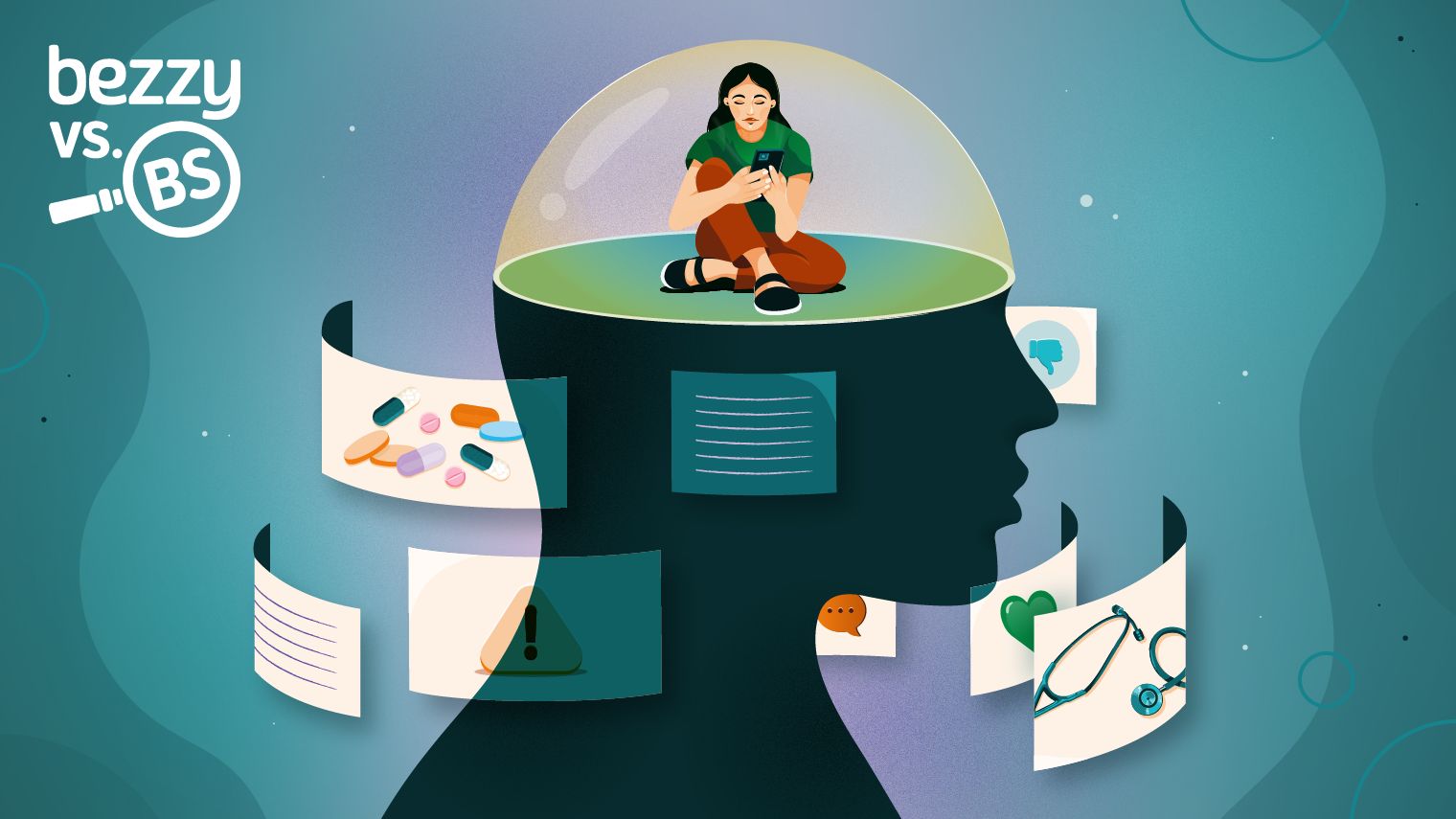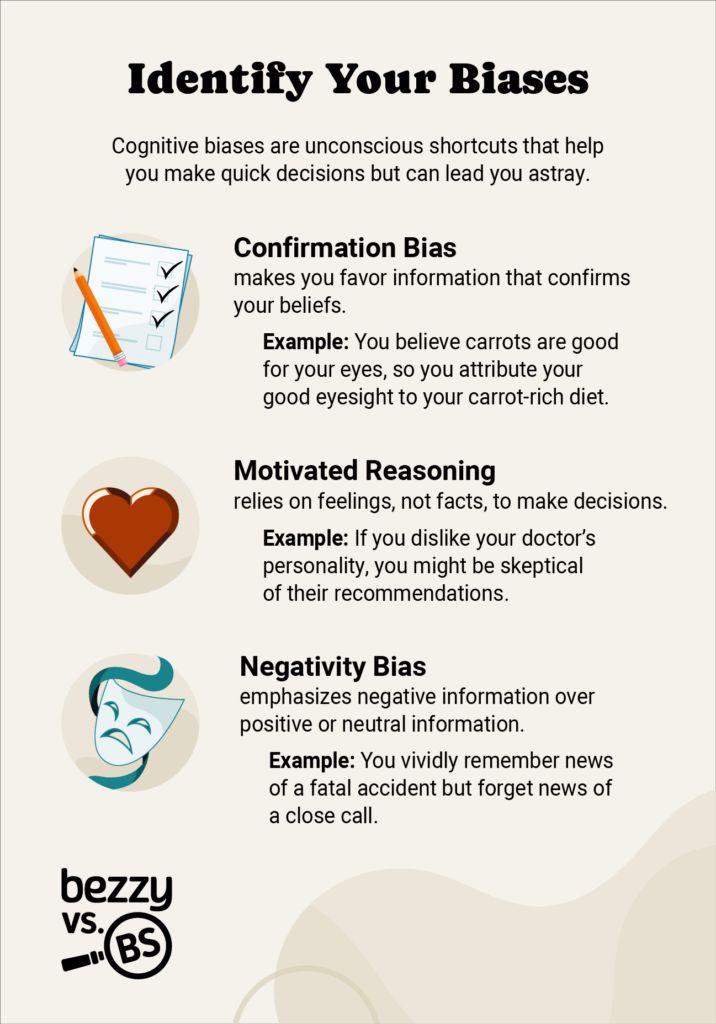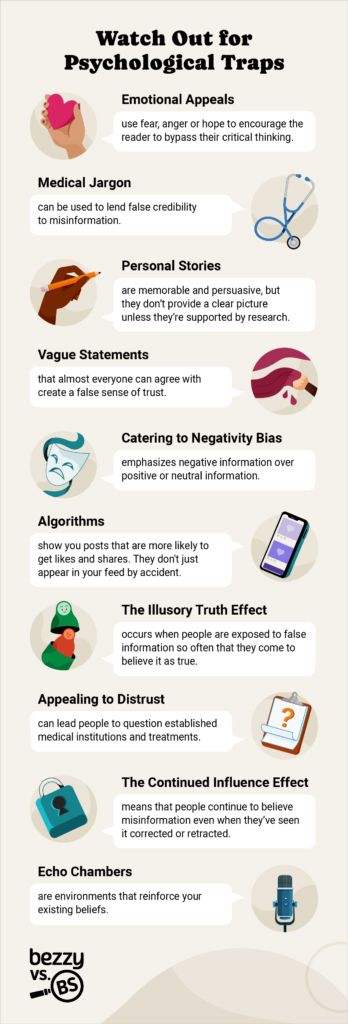The Psychology of Misinformation: Why We Buy into BS
October 01, 2024

Health misinformation is rampant. Understanding how it happens and why we too often believe it is key to protecting ourselves and others from shady shams and scams.
The internet is the ultimate mixed blessing. While having the world at our fingertips has its upsides (cat videos, anyone?), it’s become increasingly clear that this isn’t always a good thing.
Rumors, urban legends, and lies have been around for as long as humans have existed, but the digital age has supercharged the spread of misinformation. Even the most questionable “fake news” can reach millions of people in nanoseconds.
When it comes to content related to health, the spread of misinformation can have serious consequences.
Nearly everyone has fallen for health misinformation at one time or another. But it can be especially tricky when you have a chronic illness, because opportunists may see vulnerability — and a chance to take advantage.
Navigating an era when the line between fact and fiction is increasingly blurred requires understanding how we fall for misinformation — and what we can do to BS-proof ourselves.


What is misinformation?
Misinformation refers to false or misleading information that often appears as news or cutting-edge insights. It can come from social media, ads, blogs, word of mouth, or any number of other sources that haven’t been properly fact-checked.
Misinformation can be intentional or accidental. And it can spread about anything, including politics, celebrities, and wellness. But health misinformation, in particular, can have serious impacts.
Why misinformation matters
For one thing, health misinformation can lead people to delay effective medical treatment or try ineffective or potentially harmful remedies.
“Health misinformation can also undermine public health initiatives and reduce trust in healthcare systems and public health professionals,” said Michelle Burbage, PhD, director of the Master of Public Health program at the University of Cincinnati.
It can erode trust in doctors and important, evidence-based treatments. This tactic of appealing to distrust can lead people to believe persuasive influencers over established medical institutions and treatments.
The most obvious example was during the COVID-19 pandemic when inaccurate claims about treatments and vaccine safety spread like wildfire.
“Now we’re seeing misinformation have an impact on [other] vaccines,” said Jessica Kruger, clinical associate professor for the School of Public Health and Health Professions at the University at Buffalo, SUNY. “The [measles, mumps, rubella] vaccine rates in children have gone down, and measles is one of the most contagious diseases out there. When there’s an outbreak, that becomes really scary.”
Misinformation can erode trust in doctors and important, evidence-based treatments.
Why we fall for misinformation
Misinformation doesn’t grow in a vacuum. It’s fueled by our natural, primitive biases that are meant to protect us. Our brains use these biases to help us identify potential threats and process important information quickly.
However, these evolutionary biases can get hijacked by misinformation.
Identifying your biases
Cognitive biases are unconscious shortcuts that can help you make quick decisions, like assuming the glowing red element on your stove will be hot if you touch it.
These often useful shortcuts can also lead you astray, like assuming a story with a news-like headline is true. There are many common types of these biases, including confirmation bias, motivated reasoning, and negativity bias.
- Confirmation bias: This tells the brain to seek out information that confirms your existing beliefs. This is why people often seem to avoid perspectives that challenge their views. This can create echo chambers, on social media in particular, where users are exposed to more and more information that reinforces their existing beliefs, making them vulnerable to misinformation.
For example, if you believe that vitamin C prevents colds, you might take it as proof every time you take vitamin C and don’t get sick.
On the other hand, you might ignore instances where you don’t take vitamin C and still don’t get sick, or when others take it and do get sick. In short, you’re giving selective attention to information that supports your belief.
- Motivated reasoning: This is another thing your brain may do without you knowing. It involves processing information in a way that aligns with your desires and emotions. It’s similar to confirmation bias, but rather than confirming an existing belief it’s about being internally motivated to believe something.
For instance, if someone is in pain, they might be inclined to try almost any treatment or “cure,” even if it’s not well-supported by evidence. They might also be more open to believing in solutions that seem too good to be true. And that desire for relief might even be strong enough to make them think the treatment is working. - Negativity bias: This is the brain’s natural tendency to pay more attention to things that are negative, and can be a powerful fuel for false information. Our own bias can also be leveraged to manipulate us. Social media platforms are designed to maximize engagement and engineered to amplify sensational or emotionally charged content.
Often, the message is negative, and accuracy is irrelevant.

How emotions impact perception
Emotional triggers like fear, anger, and even humor are incredibly powerful. We’re far more likely to react to and share content that causes a strong emotional response.
Social media algorithms reward engagement, so we see more emotional stories in our feeds and react to those. It’s a vicious cycle.
“During COVID-19, even when medical experts wade in with facts and details, people just didn’t engage with that,” says Blevins.
On the other hand, the emotional stories get shared and reshared — and reshared some more.
“The digital space is really about emotion. We’re not making reasoned arguments anymore,” said Jeffrey Blevins, head of journalism at the University of Cincinnati and author of Social Media and Digital Politics: Networked Reason in an Age of Digital Emotion. “We’re responding to things emotionally and not rationally.”
For instance, alarmist posts with claims like, “Doctors don’t want you to know about this health secret,” prey on the fear of exclusion or being duped. Graphic images of disease captioned with “This is what happens when you don’t try X” prey on the fear of getting sick.
Education and analytical reasoning skills can help combat misinformation, while anxiety makes people more susceptible to believing it.
Alarmist posts with claims like, “Doctors don’t want you to know about this health secret,” prey on the fear of exclusion or being duped.
When familiarity trumps truth
We react to emotional content and we also give preference to familiar content. “When people are more familiar with information, they’re more likely to believe it,” said Burbage. “If my family and friends keep telling me red cats are the nicest cats, and I hear it all the time, I’m going to believe every red cat I see is very nice.”
This is known as the illusory truth effect. When you see information repeated over and over, the brain can’t distinguish familiarity from truth.
“If a person keeps hearing or seeing the same incorrect health message, they might be more susceptible to believing it’s true,” says Burbage.
She points to a recent TikTok trend that suggested that the flu could be cured by putting raw potato slices in your socks.
“Putting a potato in your sock isn’t dangerous, but not seeking medical treatment when you’re severely sick can put someone’s life at risk,” said Burbage. “If you’re seeing something on social media over and over and over again, you might start thinking, ‘there must be some truth to this, it’s working for these people, I keep seeing it.’”
This is the idea behind propaganda, which often masquerades as “education.”
In addition, it’s more difficult to correct misinformation than to prevent it from spreading. This has a name, too. Thanks to the continued influence effect, people continue to believe misinformation even after they’ve heard it corrected or retracted.
If you’re seeing something on social media over and over and over again, you might start thinking, ‘there must be some truth to this, it’s working for these people.’
— Michelle Burbage, PhD
Are you being manipulated?
No one is immune to misinformation. We’re all susceptible, from your screen-savvy Gen Z nephew to your tech-phobic neighbor who doesn’t have a smartphone.
People pedaling misinformation often exploit vulnerabilities, like youth, old age, or illness, to spread falsehoods. Persuasive tactics, like emotional appeals, appealing to distrust, and jargon, can be used to manipulate anyone.
“Determining what’s credible and accurate is difficult for the entire public,” said Burbage. Understanding psychological traps is one key to protecting yourself. Watch for these:
- Emotional appeals use fear, anger, or hope to encourage the reader to bypass their critical thinking.
- Medical jargon can be used to lend false credibility to misinformation.
- Personal stories are memorable and persuasive, but they don’t provide a clear picture unless they’re supported by research.
- Vague statements that almost everyone can agree with create a false sense of trust.
- Catering to negativity bias makes us tend to pay more attention to things that are upsetting or scary.
- Algorithms show you content that’s more likely to get clicks, comments, and shares. These stories don’t just appear in your feed by accident.
- The illusory truth effect occurs when people are exposed to false information so often that they come to believe it as true.
- Appealing to distrust can lead people to question established medical institutions and treatments.
- The continued influence effect means that people continue to believe misinformation even when they’ve seen it corrected or retracted.
- Echo chambers are online environments prioritizing content that reinforces your existing beliefs.
Be alert to these strategies and effects, and you’re more likely to recognize when you’re being manipulated.

Staying educated and informed
Staying informed in an age of misinformation does require vigilance.
Try to analyze your responses to information regularly. Ask yourself, “Why do I feel this way about this news?”
Looking at where the health information comes from is key. Then ask why that info has been created.
“Think about who wrote it, who posted it, and why are they giving out the information. What is the purpose or motive?” said Burbage.
If the source is persuading or selling, it’s more suspect than if it’s simply meant to inform in a neutral way.
Takeaway
If you’ve been fooled by misinformation, don’t beat yourself up. It happens to us all at one point or another, regardless of how tech-savvy or internet-literate we are.
You can level up your skepticism for next time and practice good “digital hygiene” by sharing responsibly. Think critically about the information you’re consuming and fact-check thoroughly before passing it along. When you share, be sure you’re confident that you’ve found something credible — not just clickable.
More Bezzy vs. BS
Food Sensitivity Testing: The Fictions Behind the Fad
Cracking the Code on Supplements: How to Spot the Best and Avoid the Rest
Truth or Hype? How to Spot Health Misinformation
Medically reviewed on October 01, 2024
6 Sources


Like the story? React, bookmark, or share below:
Have thoughts or suggestions about this article? Email us at article-feedback@bezzy.com.
About the author